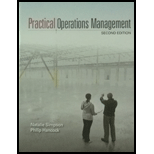
Concept explainers
a)
Interpretation: Average total time truck spends waiting.
Concept introduction: The M/M/1 queue assumes poison arrivals, exponential service times, and a single server serving customers in a FCFS fashion. Poisson arrivals are a reasonably good assumption for unscheduled systems. Further, if there is a mix of many different types of jobs the exponential distribution can be realistic for service times. Otherwise it tends to be too variable of a distribution.
a)
Answer to Problem 35P
average total time truck spends waiting20 mins.
Explanation of Solution
Given information:
Explanation:
Average number of waiting
b)
Interpretation: Probability of arriving truck must wait.
Concept introduction: The M/M/1 queue assumes poison arrivals, exponential service times, and a single server serving customers in a FCFS fashion. Poisson arrivals are a reasonably good assumption for unscheduled systems. Further if there is a mix of many different types of jobs the exponential distribution can be realistic for service times. Otherwise it tends to be too variable of a distribution.
b)
Answer to Problem 35P
probability of arriving truck must wait 0.1416 or 14.12%.
Explanation of Solution
Given information:
Explanation:
Probability of 0 in the system
Probability of N number in a queue at least 1 in the queue
c)
Interpretation: Trucks waiting in line.
Concept introduction: The M/M/1 queue assumes poison arrivals, exponential service times, and a single server serving customers in a FCFS fashion. Poisson arrivals are a reasonably good assumption for unscheduled systems. Further, if there is a mix of many different types of jobs the exponential distribution can be realistic for service times. Otherwise, it tends to be too variable of a distribution
c)
Answer to Problem 35P
4.17 trucks waiting in line
Explanation of Solution
Given information:
Explanation:
Average number of customers waiting
d)
Interpretation: Trucks at the weigh station
Concept introduction: The M/M/1 queue assumes poison arrivals, exponential service times, and a single server serving customers in a FCFS fashion. Poisson arrivals are a reasonably good assumption for unscheduled systems. Further, if there is a mix of many different types of jobs the exponential distribution can be realistic for service times. Otherwise, it tends to be too variable of a distribution
d)
Answer to Problem 35P
3 trucks at the weigh station.
Explanation of Solution
Given information:
Explanation:
Average number of trucks in the system
e)
Interpretation: Probability of no more than 3 trucks at weigh station.
Concept introduction: The M/M/1 queue assumes poison arrivals, exponential service times, and a single server serving customers in a FCFS fashion. Poisson arrivals are a reasonably good assumption for unscheduled systems. Further, if there is a mix of many different types of jobs the exponential distribution can be realistic for service times. Otherwise, it tends to be too variable of a distribution.
e)
Answer to Problem 35P
0.096 probability of no more than 3 trucks at weigh station.
Explanation of Solution
Given information:
Explanation:
N = not more than 3 trucks
Want to see more full solutions like this?
Chapter 5 Solutions
Practical Operations Management
 Practical Management ScienceOperations ManagementISBN:9781337406659Author:WINSTON, Wayne L.Publisher:Cengage,MarketingMarketingISBN:9780357033791Author:Pride, William MPublisher:South Western Educational Publishing
Practical Management ScienceOperations ManagementISBN:9781337406659Author:WINSTON, Wayne L.Publisher:Cengage,MarketingMarketingISBN:9780357033791Author:Pride, William MPublisher:South Western Educational Publishing

